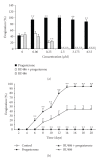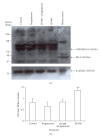Progesterone induces scolex evagination of the human parasite Taenia solium: evolutionary implications to the host-parasite relationship
- PMID: 20037735
- PMCID: PMC2796346
- DOI: 10.1155/2010/591079
Progesterone induces scolex evagination of the human parasite Taenia solium: evolutionary implications to the host-parasite relationship
Abstract
Taenia solium cysticercosis is a health problem in underdeveloped and developed countries. Sex hormones are involved in cysticercosis prevalence in female and male pigs. Here, we evaluated the effects of progesterone and its antagonist RU486 on scolex evagination, which is the initial step in the development of the adult worm. Interestingly, progesterone increased T. solium scolex evagination and worm growth, in a concentration-independent pattern. Progesterone effects could be mediated by a novel T. solium progesterone receptor (TsPR), since RU486 inhibits both scolex evagination and worm development induced by progesterone. Using RT-PCR and western blot, sequences related to progesterone receptor were detected in the parasite. A phylogenetic analysis reveals that TsPR is highly related to fish and amphibian progesterone receptors, whereas it has a distant relation with birds and mammals. Conclusively, progesterone directly acts upon T. solium cysticerci, possibly through its binding to a progesterone receptor synthesized by the parasite.
Figures





Similar articles
-
A novel progesterone receptor membrane component (PGRMC) in the human and swine parasite Taenia solium: implications to the host-parasite relationship.Parasit Vectors. 2018 Mar 9;11(1):161. doi: 10.1186/s13071-018-2703-1. Parasit Vectors. 2018. PMID: 29523160 Free PMC article.
-
Steroid hormone production by parasites: the case of Taenia crassiceps and Taenia solium cysticerci.J Steroid Biochem Mol Biol. 2003 Jun;85(2-5):221-5. doi: 10.1016/s0960-0760(03)00233-4. J Steroid Biochem Mol Biol. 2003. PMID: 12943707 Review.
-
Sequence analysis and molecular characterization of Wnt4 gene in metacestodes of Taenia solium.Korean J Parasitol. 2014 Apr;52(2):163-8. doi: 10.3347/kjp.2014.52.2.163. Epub 2014 Apr 18. Korean J Parasitol. 2014. PMID: 24850959 Free PMC article.
-
Different effects of chorionic gonadotropin on Taenia crassiceps and Taenia solium cysticerci cultured in vitro.J Parasitol. 2007 Dec;93(6):1518-20. doi: 10.1645/GE-1196.1. J Parasitol. 2007. PMID: 18314702
-
Regional status, epidemiology and impact of Taenia solium cysticercosis in Western and Central Africa.Acta Trop. 2003 Jun;87(1):35-42. doi: 10.1016/s0001-706x(03)00053-6. Acta Trop. 2003. PMID: 12781376 Review.
Cited by
-
Neurocysticercosis: a review on status in India, management, and current therapeutic interventions.Parasitol Res. 2017 Jan;116(1):21-33. doi: 10.1007/s00436-016-5278-9. Epub 2016 Oct 24. Parasitol Res. 2017. PMID: 27774576 Review.
-
Progesterone induces mucosal immunity in a rodent model of human taeniosis by Taenia solium.Int J Biol Sci. 2011;7(9):1443-56. doi: 10.7150/ijbs.7.1443. Epub 2011 Nov 10. Int J Biol Sci. 2011. PMID: 22110394 Free PMC article.
-
Untargeted serum metabolomic profiling for early detection of Schistosoma mekongi infection in mouse model.Front Cell Infect Microbiol. 2022 Aug 18;12:910177. doi: 10.3389/fcimb.2022.910177. eCollection 2022. Front Cell Infect Microbiol. 2022. PMID: 36061860 Free PMC article.
-
Host pregnancy influences the establishment of Trichinella zimbabwensis in Balb C mice.J Parasit Dis. 2017 Sep;41(3):799-804. doi: 10.1007/s12639-017-0891-9. Epub 2017 Feb 10. J Parasit Dis. 2017. PMID: 28848281 Free PMC article.
-
Sex-the most underappreciated variable in research: insights from helminth-infected hosts.Vet Res. 2022 Nov 17;53(1):94. doi: 10.1186/s13567-022-01103-3. Vet Res. 2022. PMID: 36397174 Free PMC article. Review.
References
-
- Garcia HH, Del Brutto OH. Neurocysticercosis: updated concepts about an old disease. The Lancet Neurology. 2005;4(10):653–661. - PubMed
-
- Flisser A, Sarti E, Lightowlers M, Schantz P. Neurocysticercosis: regional status, epidemiology, impact and control measures in the Americas. Acta Tropica. 2003;87(1):43–51. - PubMed
-
- White AC., Jr. Neurocysticercosis: a major cause of neurological disease worldwide. Clinical Infectious Diseases. 1997;24(2):101–113. - PubMed
-
- Fan PC, Chung WC. Sociocultural factors and local customs related to taeniasis in east Asia. The Kaohsiung Journal of Medical Sciences. 1997;13(11):647–652. - PubMed
Publication types
MeSH terms
Substances
LinkOut - more resources
Full Text Sources
Research Materials

